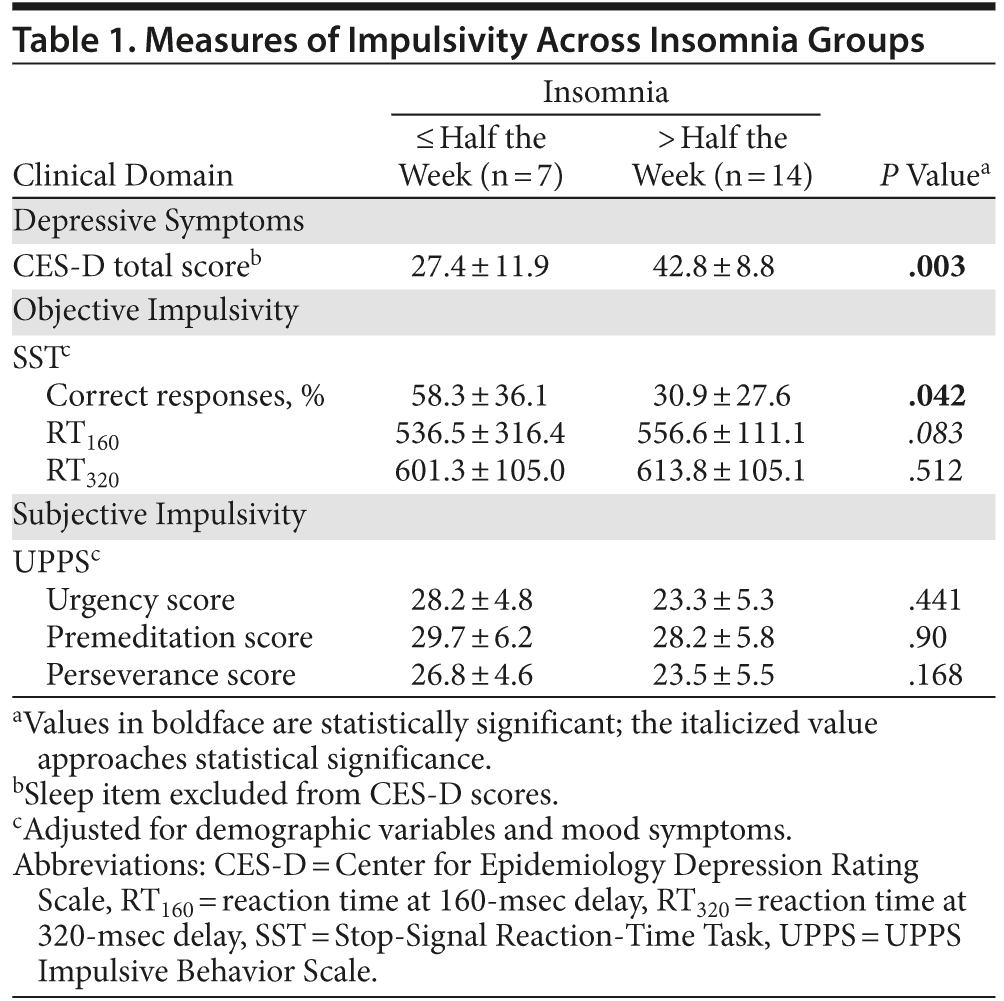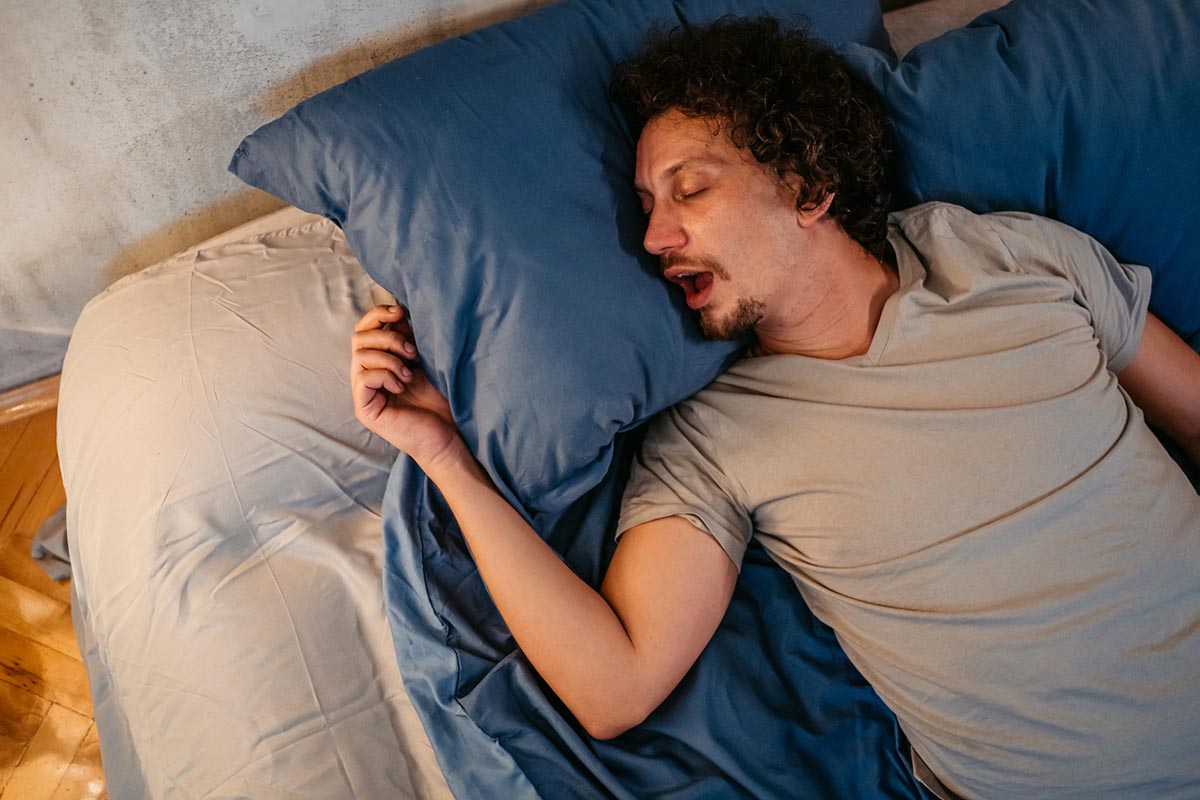Insomnia Severity Is Associated With Decreased Executive Functioning in Patients With Suicidal Ideation and Drug Abuse
To the Editor: Insomnia has been associated with decreased executive functioning in those without substance use disorders.1 Although numerous studies have linked impulsivity with substance abuse and suicidal ideation, its relationship with insomnia in the substance-abusing population is unclear.2-6 In this preliminary study, we explore the relationship of insomnia severity with objective and subjective impulsivity measured by computerized behavioral tests and a self-report questionnaire, respectively, in patients with suicidal ideation/behavior attending a psychiatric emergency department. We hypothesized that a higher insomnia severity would be associated with increased objective impulsivity (a decrease in executive functioning) and higher subjective impulsivity scores.
Method. This investigation involved secondary analyses of cross-sectional data from an ongoing study (N.S., J.L.E., unpublished data, 2012). Subjects were adults (N = 21, ≤ 65 years of age) who presented with suicidal ideation/behavior between July 2012 and December 2012 to the emergency department, where they were observed until their symptoms stabilized. We excluded patients with any motor response, visual or hearing disorders, psychotic symptoms, or inability to read or comprehend English. The instruments used in this study included the following:
1. The Stop-Signal Reaction-Time Task,7 which assesses objective impulsivity through response inhibition (a facet of executive functioning) based on correct responses and reaction times7,8;
2. The UPPS Impulsive Behavior Scale,9 which is a 45-item self-report measure that assesses personality aspects of subjective impulsivity (the "S" sensation-seeking component was excluded in this protocol);
3. The sleep question from the Center for Epidemiology Studies-Depression Scale (CES-D),10 which assesses insomnia by inquiring, "Over last week, my sleep was restless’ ¦." with the responses arrayed as "less than a day," "1-2 days," "3-4 days," and "5-7 days." The responses were categorized into "frequent" (ie, those with restless sleep for ≥ 5 nights/wk) or "infrequent" (those with ≤ 4 nights/wk) insomnia on the basis of the distribution of responses, clinical significance, and similarity to analyses from prior literature11;
4. The remaining CES-D items, which assess depressive symptoms.
The institutional review board approved the study, and subjects signed informed consent prior to participation.
Results. The demographic variables included the following: the mean age was 38.3 (SD = 10.1) years, 18 (85.7%) identified themselves as African American, 18 (85.7%) were male, 9 (42.9%) were single, 16 (76.2%) were unemployed, 8 (38.1%) had ≥ 12 years of education, and 12 (57.1%) reported being homeless. Urine drug screens at admission were positive in 14 (66.7%) for cocaine, 6 (28.6%) for cannabis, 5 (23.8%) for phencyclidine, 4 (19.0%) for sedative-hypnotic medications, and 3 (14.3%) for opioids. Four subjects (19.0%) reported use of only 1 drug (cocaine).
Subjects with frequent insomnia had significantly higher CES-D scores. In analyses adjusted for demographic and mood covariates, those with frequent insomnia (as compared to those with infrequent insomnia) had a significantly decreased number of correct responses and a higher mean reaction time at 160 ms. Similarly, a higher reaction time was seen at 320 ms for this group, although this was not statistically significant. Those with frequent insomnia (in comparison to those with infrequent insomnia) had nonsignificantly lower scores on the UPPS impulsivity scales (see Table 1).
The limitations associated with this preliminary study include the lack of a formal standardized insomnia rating instrument, the small sample size, and its cross-sectional nature. Despite the limitations, we observed that frequent sleep impairment was associated with a lower response inhibition on the Stop Signal Reaction Time Task without any difference in the personality aspects of impulsivity in this complex sample. These results suggest that improving sleep in this population might help improve mood and executive functioning and thus reduce the likelihood of behaviors precipitating visits to the emergency department. Future studies should assess for subjective and objective insomnia using standardized instruments and expand the range of impulsivity facets being assessed.
References
1. Fortier-Brochu E, Beaulieu-Bonneau S, Ivers H, et al. Insomnia and
daytime cognitive performance: a meta-analysis. Sleep Med Rev. 2012;16(1):83-94. PubMed doi:10.1016/j.smrv.2011.03.008
2. Albein-Urios N, Martinez-Gonzalez JM, Lozano O, et al. Negative
urgency, disinhibition and reduced temporal pole gray matter
characterize the comorbidity of cocaine dependence and personality disorders [published online ahead of print March 2, 2013]. Drug
Alcohol Depend. PubMed doi:10.1016/j.drugalcdep.2013.02.008
3. Moshier SJ, Ewen M, Otto MW. Impulsivity as a moderator of the intention-behavior relationship for illicit drug use in patients undergoing treatment. Addict Behav. 2013;38(3):1651-1655. PubMed doi:10.1016/j.addbeh.2012.09.008
4. Swann AC, Dougherty DM, Pazzaglia PJ, et al. Increased impulsivity associated with severity of suicide attempt history in patients with bipolar disorder. Am J Psychiatry. 2005;162(9):1680-1687. PubMed doi:10.1176/appi.ajp.162.9.1680
5. Gorlyn M. Impulsivity in the prediction of suicidal behavior in adolescent populations. Int J Adolesc Med Health. 2005;17(3):205-209. PubMed doi:10.1515/IJAMH.2005.17.3.205
6. Grano NK-JL, Kouvonen A, Puttoneon S, et al. Association of impulsivity with sleep duration and insomnia in an employee population. Pers Individ Dif. 2007;43(2):307-318. doi:10.1016/j.paid.2006.11.022
7. Evenden JL. One Choice Stop Signal Task [computer program]. http://www.wiltonlogic.com/products/imp/ocss.html. Media, PA: WiltonLogic; 2012.
8. Logan GD, Cowan WB. On the ability to inhibit thought and action: a theory of an act of control. Psychol Rev. 1984;91(3):295-327. doi:10.1037/0033-295X.91.3.295
9. Whiteside SP, Lynam DR, Miller JD, et al. Validation of the UPPS impulsive behavior scale: a four factor model of impulsivity. Eur J Pers. 2005;19(7):559-574. doi:10.1002/per.556
10. Radloff LS. The CES-D Scale: a self-report depression scale for research in the general population. Appl Psychol Meas. 1977;1(3):385-401. doi:10.1177/014662167700100306
11. Bonnet MH, Arand DL. Clinical effects of sleep fragmentation versus sleep deprivation. Sleep Med Rev. 2003;7(4):297-310. PubMed doi:10.1053/smrv.2001.0245
Author affiliations: Department of Public Health, West Chester University of Pennsylvania, West Chester (Dr Chaudhary); Department of Behavioral Sleep Medicine, Perelman School of Medicine of the University of Pennsylvania, Philadelphia (Dr Chaudhary and Dr Chakravorty); Department of Psychiatry, Temple University School of Medicine, Philadelphia (Drs Evenden and Sanuck); WiltonLogic LLC, Media (Dr Evenden); and Department of Psychiatry, Philadelphia Veterans Affairs Medical Center, Philadelphia (Dr Chakavorty), Pennsylvania.
Potential conflicts of interest: Dr Evenden is an employee of WiltonLogic LLC and has served on the speakers or advisory boards for H Lundbeck A/S. Drs Chaudhary, Chakravorty, and Sanuck report no potential conflict of interest relevant to the subject of this letter.
Funding/support: None reported.
Published online: October 31, 2013.
Prim Care Companion CNS Disord 2013;15(5):doi:10.4088/PCC.13l01548
© Copyright 2013 Physicians Postgraduate Press, Inc.




